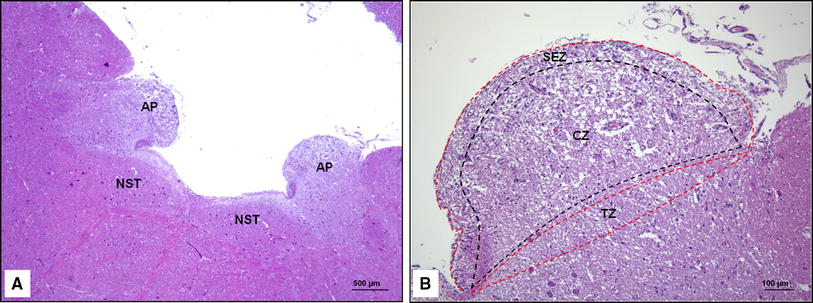Summary
Scanning electron microscopy and the penetration of horseradish peroxidase, especially from the ventricular surface, has been utilized to determine the distinctive properties of the posterior portion of the area postrema. This part of the organ is characterized by a non-ciliated surface composed of flattened cells, which appear less permeable to cisternally injected peroxidase than the ciliated ependymal cells covering the anterior part of the area postrema. However, more diffuse and rapid penetration of peroxidase into the posterior region is achieved by way of the perivascular spaces which appear in direct communication with the CSF. No such filling is noted in the anterior area postrema. The posterior portion also contains cells which appear to be rapidly penetrated by horseradish peroxidase and which may be important as a sensing mechanism. The chief distinction of the anterior part of the area postrema appears to be the presence of vascular connections with the choroid plexus.
Similar content being viewed by others
References
Fuxe, K., Owman, C.: Cellular localization of monamines in the area postrema of certain mammals. J. comp. Neurol. 125, 336–344 (1965).
Graham, R. C., Jr., Karnovsky, M. J.: The early stages of absorption of injected horseradish peroxidase in the proximal tubules of mouse kidney. J. Histochem. Cytochem. 14, 291–302 (1966).
Hashimoto, P. H., Hama, K.: An electron microscopic study on protein uptake into brain regions devoid of the blood-brain barrier. Medjosaka University 18, 331–346 (1968).
Karnovsky, M. J.: The ultrastructural basis of capillary permeability studied with peroxidase as a tracer. J. Cell Biol. 35, 213–236 (1967).
Koella, N. P., Sutin, J.: Extra blood-brarrier structures. Int. Rev. Neurobiol. 10, 31–55 (1968).
Kroidl, R.: Die arterielle and venöse Versorgung der Area postrema der Ratte. Z. Zellforsch. 89, 430–452 (1968).
Leonhardt, H.: Über die Blutkapillaren und perivaskulären Strukturen der Area postrema des Kaninchens und über ihr Verhalten im Pentamethylentetrazol-(cardiazol) Krampf. Z. Zellforsch. 76, 511–524 (1967).
Mitchell, R. A., Massion, W., Carman, C. T., Severinghaus, J. W.: 4th ventricle respiratory chemosensitivity and the area postrema. Fed. Proc. 19, 374 (1960).
Shimizu, N., Ishii, S.: Fine structure of the area postrema of the rabbit brain. Z. Zellforsch. 64, 462–473 (1964).
Smith, M., Finke, E. H.: Critical point drying of biological material for scanning electron microscopy. (In preparation.)
Torack, R. M.: The penetration of sodium into the brain following a cisternal injection of sodium chloride with particular emphasis on the area postrema. Z. Zellforsch. 113, 1–12 (1971).
—, LaValle, M. C.: The specificity of the pyroantimonate technique to demonstrate sodium. J. Histochem. Cytochem. 18, 635–643 (1970).
Wislocki, G. B., Putnam, T. J.: Note on the anatomy of the area postrema. Anat. Reo. 19, 281–285 (1920).
Woollard, H. H.: Vital staining of the leptomeninges. J. Anat. (Lond.) 58, 89–100 (1924).
Author information
Authors and Affiliations
Additional information
This work has been supported in part by Grant NB08549-02 from the National Institute of Neurological Diseases and Stroke and Health Science Advancement Award F-304-FR06115.
Rights and permissions
About this article
Cite this article
Torack, R.M., Finke, E.H. Evidence for a sequestration of function within the area postrema based on scanning electron microscopy and the penetration of horseradish peroxidase. Z. Zellforsch. 118, 85–96 (1971). https://doi.org/10.1007/BF00331768
Received:
Issue Date:
DOI: https://doi.org/10.1007/BF00331768




